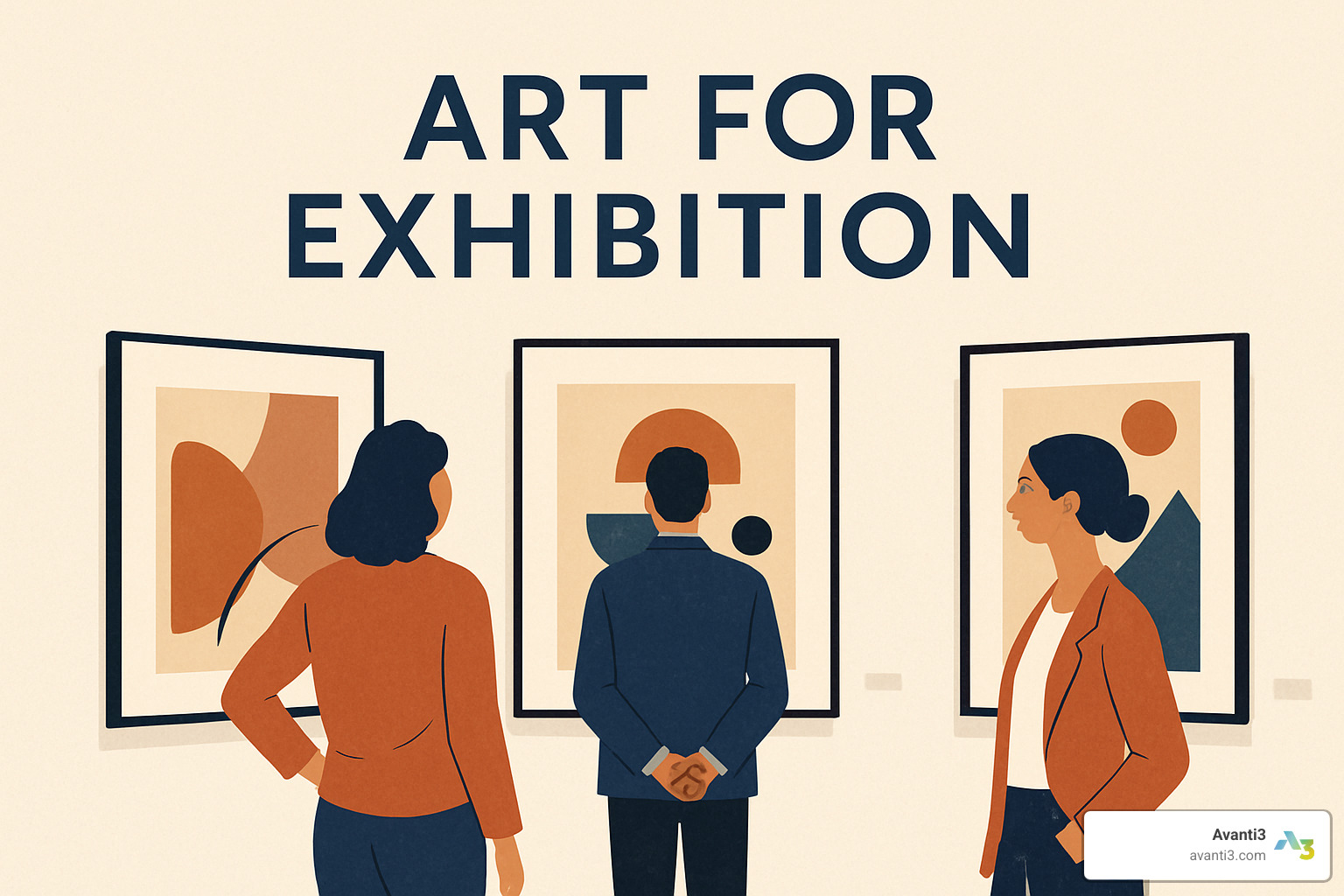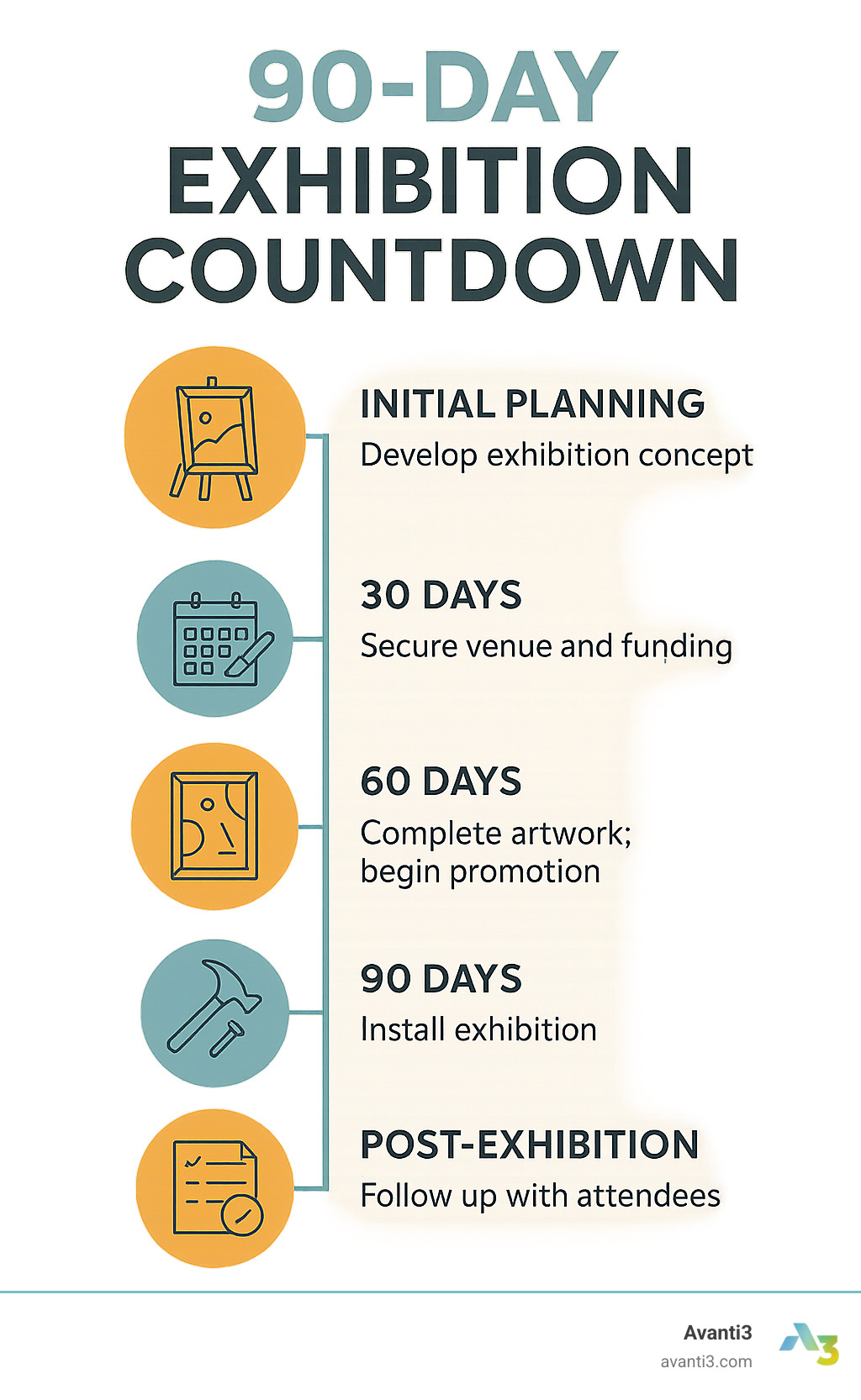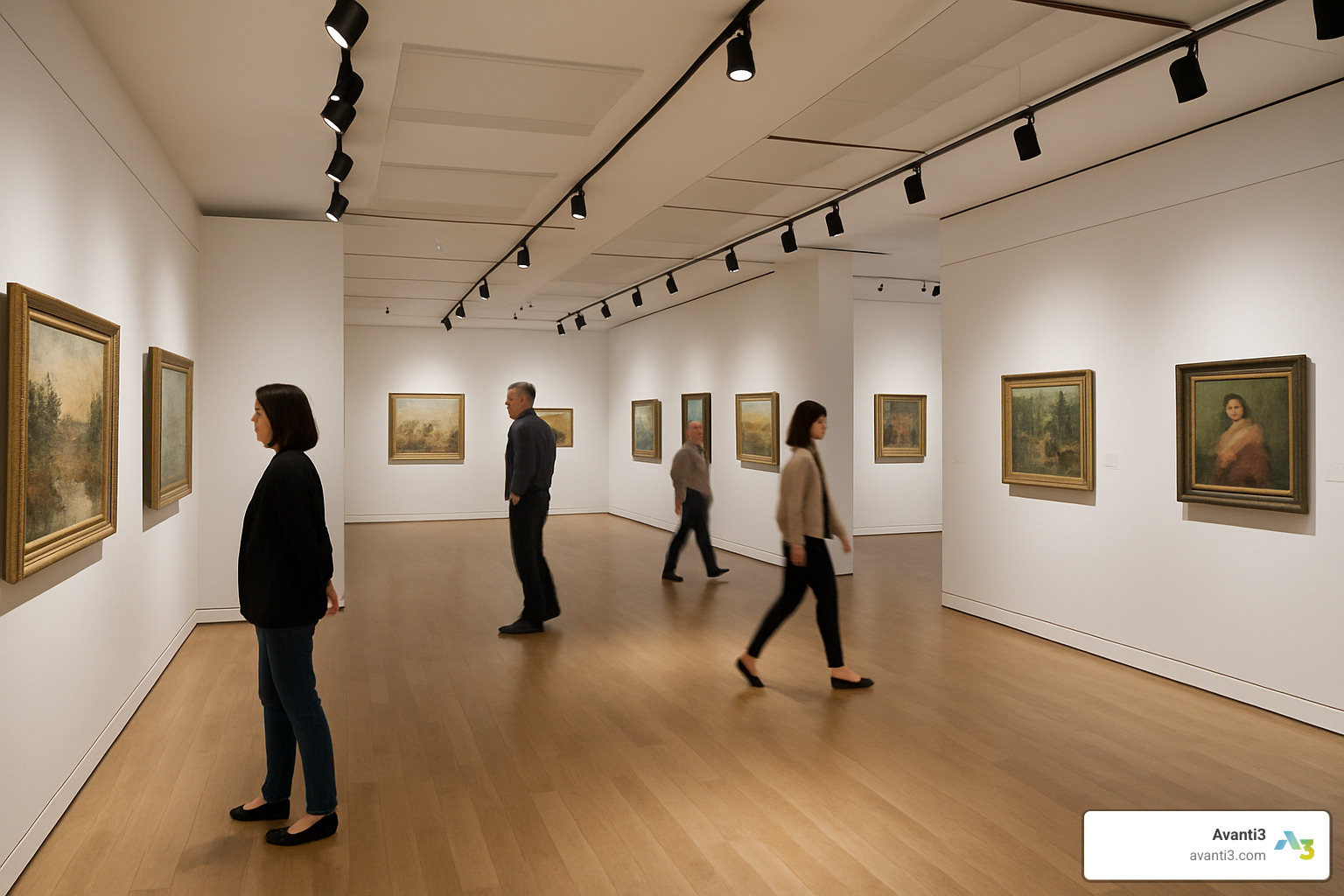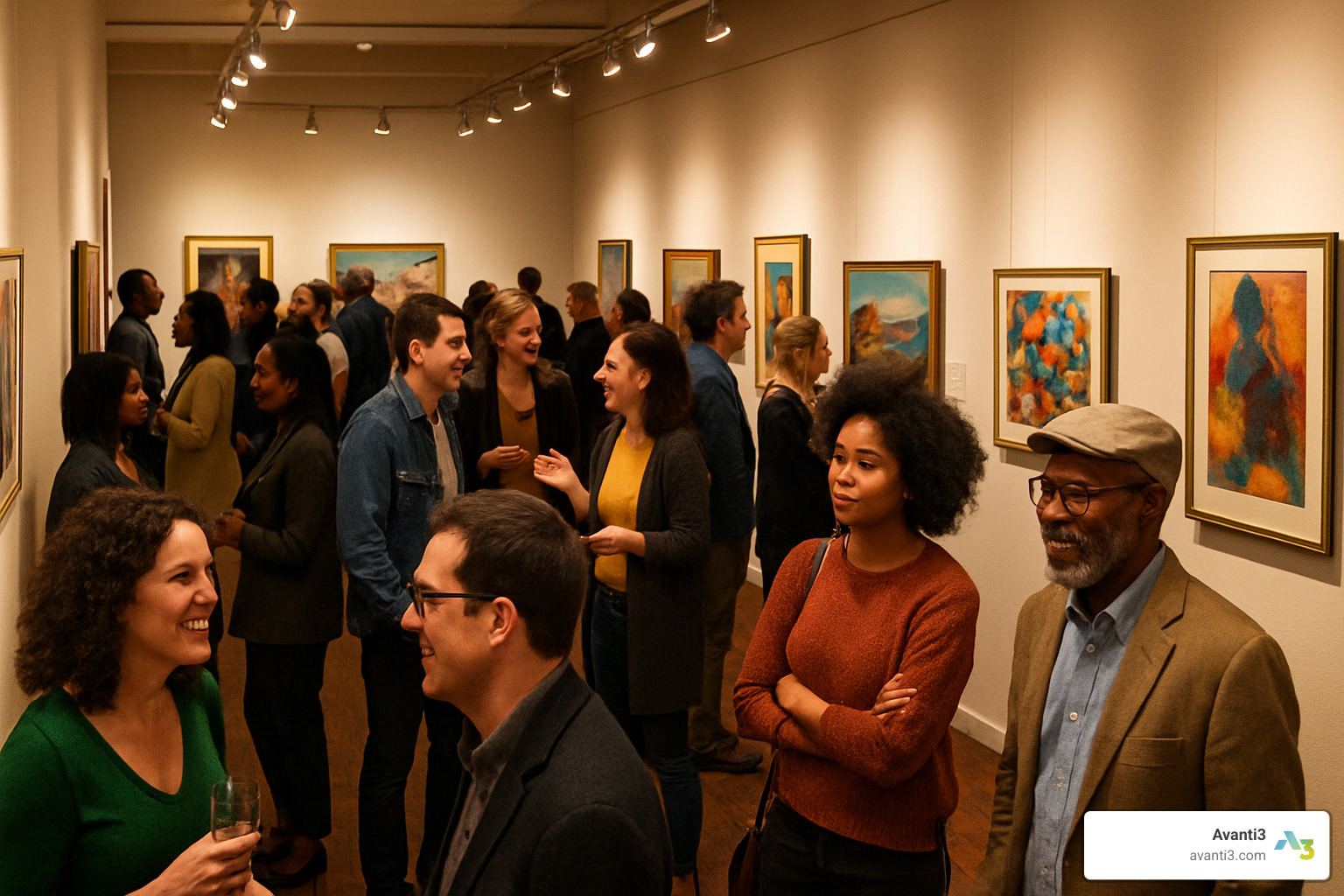Art for Exhibition: 10 Powerful Ways to Achieve Success in 2025
Why Art for Exhibition is Your Gateway to Career Success
Art for exhibition represents the pivotal moment when your creative work transitions from private studio practice to public dialogue. Whether you’re preparing for your first solo show, joining a group exhibition, or exploring virtual galleries, understanding how to properly prepare and present your work can make the difference between a forgettable display and a career-defining moment.
Key elements for successful art exhibitions:
- Exhibition types: Solo shows for focused impact, group shows for community building, institutional displays for credibility
- Preparation essentials: Concept development, artwork selection, professional documentation, venue selection
- Digital integration: Virtual tours, AR experiences, online viewing rooms expanding global reach
- Timeline planning: 3-6 months minimum for physical shows, 2-3 months for digital exhibitions
- Budget considerations: Venue costs, insurance, shipping, marketing, and 10% contingency fund
The art world has dramatically evolved since 2020. Online exhibitions have surged in importance, with platforms like Artsteps hosting millions of virtual shows. Meanwhile, traditional institutions continue awarding significant grants – Phoenix Art Museum alone has distributed over $350,000 to emerging artists since 1986.
I’m Samir ElKamouny AV, and through my work helping creators and brands build innovative audience engagement strategies, I’ve guided numerous artists through the complex journey of preparing art for exhibition in both traditional and Web3 spaces.

Understanding the World of Art Exhibitions
Think of art exhibitions as bridges between your studio and the world. They’re where your private creative journey becomes a public conversation, where viewers find your work for the first time, and where careers can truly take flight.
The exhibition landscape offers eight distinct pathways, each with its own personality and purpose. From intimate solo shows to busy art fairs, from prestigious museum walls to cutting-edge virtual galleries – understanding these options helps you choose the right stage for your artistic voice.
Exhibition Types & Their Objectives Comparison:
| Exhibition Type | Best For | Timeline | Investment Level | Audience Reach |
|---|---|---|---|---|
| Solo | Established body of work | 6-12 months | High | Focused |
| Group | Building community | 3-6 months | Shared | Diverse |
| Institutional | Career validation | 12+ months | Medium | Targeted |
| Museum | Major milestone | 2+ years | Low (for artist) | Broad |
| Online | Global accessibility | 2-3 months | Low-Medium | Unlimited |
What is an Art Exhibition?
An art for exhibition experience is essentially storytelling through visual means. It’s not just artwork hanging on walls – it’s a carefully crafted narrative that guides visitors through an emotional and intellectual journey.
Every exhibition has an invisible narrator: the curator. Even when you’re organizing your own show, you’re wearing this curator hat, making crucial decisions about which pieces deserve the spotlight and how they’ll speak to each other.
Main Exhibition Formats & When to Use Them
Solo exhibitions are like having the entire stage to yourself. They showcase your artistic evolution and give you complete creative control over the narrative. They work best when you have a cohesive body of work – typically 15-30 pieces that feel like chapters in the same story.
Group exhibitions create fascinating artistic conversations. When multiple artists explore similar themes, their pieces can spark unexpected dialogues. These shows are perfect for emerging artists who want to benefit from association with more established names.
Institutional exhibitions offer something money can’t buy: credibility. When a respected art center selects your work, they’re essentially vouching for your artistic merit.
Museum exhibitions represent the art world’s highest honor. These shows typically feature extensive research, scholarly catalogs, and comprehensive educational programming.
Online exhibitions have revolutionized accessibility in the art world. Through platforms like Artsteps, artists can create immersive virtual galleries that reach global audiences without geographical limitations.
Full List of Exhibitions showcases the incredible variety of exhibition formats available to today’s artists.
Choosing the Right Path for Your “art for exhibition” Debut
Your first exhibition choice should feel like putting on clothes that fit perfectly – comfortable, authentic, and appropriate for the occasion. Early-career artists often find group exhibitions provide the ideal training ground, offering community support while sharing costs and responsibilities.
Consider your natural working style and resource availability. Solo exhibitions demand more financial investment and logistical coordination, while group shows distribute these burdens among participants.
Crafting Your Concept & Selecting Works

Creating a compelling exhibition starts with finding the thread that connects your artwork into a story worth telling. This isn’t about forcing unrelated pieces together – it’s about finding the natural conversations already happening within your body of work.
Start by spreading out photos of your available pieces. Notice what draws your attention – recurring colors, emotional undertones, or technical explorations that evolved over time.
Theme development works best when it feels organic rather than forced. Your exhibition concept should feel like a natural extension of your artistic practice. Create mood boards and visual maps during this findy phase. Consider the narrative arc your visitors will experience.
Don’t forget about sustainability in your planning and pricing strategy early in the process. Your exhibition prices should reflect both market reality and the context of the show.
Turning Ideas into a Curatorial Framework
Now comes the exciting part – changing your loose concept into a solid curatorial framework that can guide every decision moving forward.
Write your artist statement as if you’re explaining your show to an interested friend over coffee. What’s the central idea that makes this exhibition necessary? Why do these pieces belong together?
Develop keywords that capture your exhibition’s essence. Think about your visitor takeaway – what do you want people to feel when they leave? Build feedback loops into your planning process by sharing your concept with trusted colleagues.
Preparing Artwork Physically & Digitally for “art for exhibition”
Getting your artwork exhibition-ready involves both traditional preparation and modern digital requirements. The physical side goes beyond just framing – consider conservation needs carefully.
Professional high-resolution imaging has become absolutely essential for any serious exhibition. Create detailed metadata for each piece including dimensions, materials, creation date, and relevant backstory.
Certificates of authenticity have evolved beyond simple paper documents. Blockchain Art Authentication offers innovative solutions for creating permanent, unforgeable records of your work’s provenance.
Even if you’re planning a traditional physical exhibition, prepare high-quality digital versions of your work. Today’s art world seamlessly blends physical and digital experiences.
Planning, Funding, and Logistics

The magic of art for exhibition happens long before visitors walk through your gallery doors. Behind every stunning display lies months of careful planning, strategic budgeting, and countless logistical decisions.
Physical exhibitions typically need 3-6 months of preparation time, while digital shows require at least 2-3 months. Start by working backward from your opening date. Mark crucial deadlines and build buffer time into every stage.
Your budget needs to account for venue rental, insurance, transportation costs, professional photography, promotional materials, and installation supplies. Always include a 10% contingency fund for surprise costs.
Documentation protects everyone involved. Clear contracts and agreements prevent misunderstandings and establish professional credibility. Don’t treat accessibility as an afterthought – ensure your venue welcomes visitors with disabilities from the beginning.
Securing a Venue—Physical or Virtual
Your venue choice shapes everything about your exhibition experience. Traditional galleries offer established audiences but fierce competition and high costs. Unconventional spaces often create more memorable experiences while being budget-friendly.
The digital revolution has transformed venue possibilities. Virtual Art Experiences break down geographical barriers, allowing global collectors to experience your work intimately. Platforms like Artsteps let you create sophisticated virtual reality exhibitions.
Hybrid approaches give you the best of both worlds – energetic physical openings with online versions that extend your exhibition’s lifespan indefinitely.
Financing Your Exhibition Dream
Exhibitions cost money, and creative funding requires persistence and ingenuity. Traditional grants remain vital – institutions like Phoenix Art Museum have distributed over $350,000 to Arizona artists since 1986.
Professional sponsorship materials make all the difference when approaching potential supporters. Crowdfunding has become legitimate for exhibition funding, but success demands compelling storytelling and attractive supporter rewards.
Artwork pre-sales provide crucial funding while building anticipation. Community partnerships can dramatically reduce costs while expanding your audience reach.
Using Tech & Data
Technology integration transforms both creation and presentation of art for exhibition. Virtual tours extend your exhibition’s impact beyond physical limitations, while augmented reality adds interactive layers.
Data analytics provide insights into visitor behavior that inform future exhibitions. NFTs and blockchain technology open new possibilities for art authentication and sales. AR/VR Immersive Experiences create innovative ways for audiences to interact with your work.
Installing & Presenting Art for Exhibition Success

The moment when your art for exhibition transforms from concept to reality happens during installation. Every choice about placement, lighting, and flow shapes how visitors connect with your work.
Lighting can make or break your exhibition. Natural light feels wonderful but changes throughout the day and can fade materials. Artificial lighting gives you control, but requires careful testing with your actual pieces.
Visitors naturally follow sight lines and tend to turn right when entering rooms. Work with these patterns to create logical flow that supports your exhibition’s story while avoiding crowded corners.
Wall text serves as your voice when you can’t be there. Keep main labels simple – title, medium, date, and price if applicable. Save longer explanations for secondary text that interested visitors can choose to read.
Security doesn’t mean turning your exhibition into Fort Knox. Simple measures like proper lighting, clear sight lines, and basic environmental controls protect your work while keeping the atmosphere welcoming.
Integrating Immersive Elements into Your “art for exhibition”
Today’s exhibitions go beyond traditional “look but don’t touch” experiences. QR codes placed discreetly near artworks can connect visitors to artist interviews, process videos, or background information without cluttering your physical space.
Audio guides have evolved from clunky rental devices to sleek smartphone apps. The integration of augmented reality creates magical moments where digital content improves physical artworks. Augmented Reality NFTs can bring static pieces to life.
Interactive stations invite deeper engagement with your artistic concepts through digital portfolios, touchscreen catalogs, or hands-on activities.
Best Practices for On-Site & Online Audience Flow
Creating intuitive wayfinding means visitors can focus on your art instead of figuring out where to go next. Storyline pacing prevents gallery fatigue that makes visitors rush past your works.
Virtual exhibitions require different strategies but the same thoughtful approach. Navigation cues become critical when visitors can’t rely on familiar spatial relationships. Scientific research on visitor engagement shows that clear, intuitive controls significantly increase time spent with online exhibitions.
The goal isn’t showing off every cool technology available, but thoughtfully integrating elements that genuinely improve how people experience your art for exhibition.
Promotion, Launch & Post-Show Momentum

Your promotional strategy becomes the bridge between your creative vision and audiences who need to experience it. Think of marketing as an extension of your artistic practice – another way to tell your story.
Start building buzz at least six weeks before your opening. Your press release should read like a compelling story, positioning your exhibition within larger cultural conversations.
Social media campaigns work best when they feel authentic. Share glimpses of your installation process, breakthrough findies, behind-the-scenes moments. Your email list represents your most dedicated supporters – give them exclusive previews and intimate artist insights.
Opening receptions create community around your work. Consider livestreaming portions for supporters who can’t attend physically, acknowledging that your audience extends beyond geographical boundaries.
Expanding Reach Beyond the White Cube
Hybrid events combining physical and virtual elements can dramatically expand your reach. Cross-sector collaborations introduce your work to entirely new communities who share your values.
NFT drops can complement traditional exhibition sales while engaging digitally-native collectors. NFT Digital Art Sales offer innovative ways to extend your exhibition’s commercial potential.
Podcast appearances and webinar presentations position you as a thoughtful voice in contemporary art discourse, often reaching highly engaged audiences who become long-term supporters.
Documenting & Reflecting After “art for exhibition” Ends
Your exhibition’s impact doesn’t end when the last visitor leaves. High-resolution photography captures not just individual pieces but the overall experience you created. Video walkthroughs preserve the dynamic experience of moving through your exhibition space.
Visitor feedback provides invaluable insights for future exhibitions. Compile press clippings and social media mentions systematically – this third-party validation proves invaluable for future opportunities.
Most importantly, maintain a self-assessment journal while memories remain fresh. These honest reflections become the foundation for even stronger future exhibitions. The end of one exhibition marks the beginning of planning the next.
Frequently Asked Questions about Preparing Art for Exhibition
Planning your first exhibition can feel overwhelming, especially when you’re juggling creative vision with practical logistics. These are the questions I hear most often from artists preparing their art for exhibition debut, along with honest answers based on real-world experience.
How far in advance should I start planning?
The short answer? Start earlier than you think you need to. Physical exhibitions typically demand 3-6 months of advance planning, while digital shows need at least 2-3 months minimum. But here’s what those timelines actually look like in practice.
Your first month should focus on concept development and artwork selection. This isn’t just picking your favorite pieces – you’re building a cohesive narrative that will guide every other decision. Month two typically involves venue research and booking, which can be surprisingly time-consuming as you compare options and negotiate terms.
Grant applications and institutional venues require even longer lead times – sometimes 6-12 months ahead. Many artists don’t realize that prestigious venues book their calendars far in advance, and funding applications often have specific deadlines that won’t wait for your ideal timeline.
Digital exhibitions offer more flexibility, but don’t let that fool you into rushing. Quality virtual presentations require careful photography, platform setup, and technical testing. The good news? Once you’ve created digital assets, they can be repurposed for multiple online exhibitions and promotional uses.
What insurance do I need for shipped artworks?
Art insurance isn’t optional – it’s essential protection for your creative investment. You’ll need two main types of coverage, and understanding the difference could save you thousands of dollars in potential losses.
Transit insurance covers your artwork during shipping from your studio to the exhibition venue and back again. This protects against damage, loss, or theft while pieces are in transport. Work with carriers experienced in handling fine art, as they understand proper packing techniques and climate control requirements.
Exhibition insurance protects pieces while they’re on display. This covers everything from visitor accidents to environmental damage during the show. Some venues provide their own coverage, but verify the details carefully – their policy might not fully cover your work’s value.
Professional art insurers understand how to properly value creative work, which can be tricky for emerging artists without established market prices. Document everything thoroughly with professional photography and detailed condition reports before your work leaves your studio. These records become crucial if you ever need to file a claim.
How do virtual exhibitions compare to physical shows in sales potential?
This question gets to the heart of how the art world has evolved, especially since online exhibitions became mainstream. The answer isn’t straightforward because both formats offer unique advantages that smart artists can leverage.
Virtual exhibitions reach global audiences without geographical limitations. Your show can remain accessible 24/7 long after a physical exhibition closes, giving potential collectors unlimited time to find and consider your work. This extended visibility often translates to sales that continue months after your initial launch.
However, many collectors still prefer seeing work in person before making significant purchases. There’s something irreplaceable about experiencing artwork’s scale, texture, and physical presence that even the best digital photography can’t fully capture.
The most successful artists I work with don’t choose between physical and virtual – they combine both approaches strategically. A physical exhibition creates local buzz and allows for in-person collector relationships, while virtual components extend reach globally and provide ongoing sales opportunities.
Digital exhibitions also offer innovative sales possibilities that physical shows can’t match. Interactive features, augmented reality experiences, and even NFT components can create entirely new ways for collectors to engage with and purchase your work. The key is understanding your audience and choosing the approach that best serves both your artistic vision and business goals.
Conclusion
Preparing art for exhibition represents one of the most exciting journeys in an artist’s career. From those first concept notes through the final visitor walking out your door, every step teaches you something new about your work and yourself.
The art world has changed dramatically in recent years. Digital technologies aren’t just nice extras anymore – they’re essential tools that can make or break your exhibition’s success. The smartest artists today blend both worlds, creating exhibitions that work in person and online.
Success comes from balancing your artistic vision with smart planning. Yes, you need to dream big and take creative risks. But you also need professional photos, clear budgets, and backup plans for when things go sideways.
Your exhibition becomes part of a bigger conversation. It connects your studio practice to the wider art world. It turns your private creative process into shared human experience.
At Avanti3, we’ve watched countless artists transform their careers through smart exhibition strategies. Our Web3 technologies – from NFT integration to blockchain authentication to immersive AR/VR experiences – give you tools that didn’t exist even five years ago. We’re helping you expand what’s possible.
Ready to take your next exhibition beyond anything you’ve imagined? Virtual Art Experiences shows how we can help your studio work reach global audiences while keeping that personal connection that makes art matter.
Your art deserves to be seen. With thoughtful preparation, creative problem-solving, and the right mix of traditional and digital tools, your next exhibition could be the moment everything changes.
The art world is waiting for what you have to say. Let’s make sure they hear it loud and clear.







